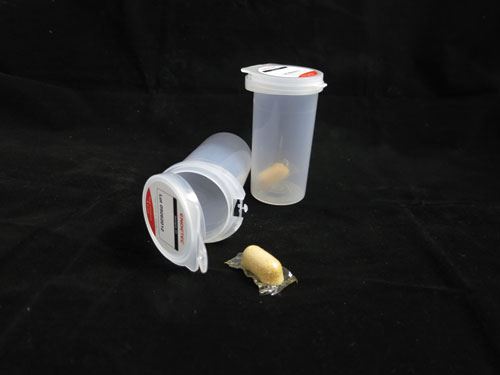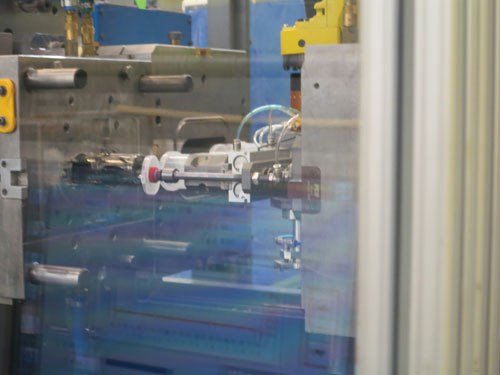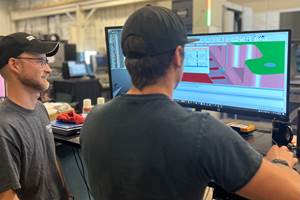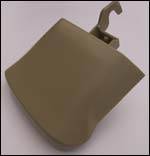Unique Mold Challenge Showcases Moldmaker as Customer Consultant
Ultimately, the Roembke Mfg. mold was a single-drop cold deck with a standard LSR valve gate design featuring side injection versus back injection for the plastic.
Most mold manufacturers today realize that delivering a quality mold on time is so much more than simply designing and building a mold. The challenge lies in closely collaborating with the customer to deliver the mold that will result in a fully functional product—all while saving the customer time and money.
Roembke Mfg. & Design, Inc. (Ossian, IN)—a manufacturer of inserted flashless rubber molds—was more than ready to rise to the challenge of working closely with its customer to deliver a two-shot mold for a water test cartridge system. “With today's challenging product lines, many times the design of the mold to just make the part can be very simple,” Roembke Mfg. CEO Greg Roembke explains. “The challenges come when the mold design has to allow the part to stay 100 percent on the A or B side and to present the part to the demolding device in a manner that will allow 100 percent, trouble-free automation. The challenge with the WT Vial for us was to work with the customer in development of plastic and LSR product materials to allow the final product to be functional—and also allow the product to be molded in a two-shot process.
“We find that moldmakers today need to not just design and build the molds, but they need to be the customer consultants that work closely and diligently together to provide engineering resources and help keep the project on schedule,” Roembke continues. “Many companies that come to us with a product to be molded don't have these resources available internally—and without proper consultation and advice—the project can fail.”
Project Background
The annual increase of acute gastrointestinal illnesses (EPA estimation over 4 million) has been predominantly attributed to public drinking water systems in the U.S. This has driven the need to develop new microbiological test methods that are faster and easier to use than traditional methods. Currently, typical laboratory water vial testing samples can take up to two weeks of processing for final results of clean water−free of harmful E.coli and Total Coliform bacteria contamination.
A revolutionary new turnkey single-use water test cartridge and automated monitoring system has been recently developed to reduce this process to within two to 18 hours—depending on the level of contamination. The water test cartridge incorporates overmolded rigid plastic and optical grade LSR (liquid silicone rubber) in a fully automated production process. The test cartridge leverages a two-shot mold and subsequent robotic transfer into an integrated assembly cell to complete six processes outside of the molding area, and then put in a box ready to ship.
The water test cartridge system is a result of a dedicated collaboration over approximately three years by the following entities: Roembke Mfg., water sensor and monitoring company ENDETEC™ (Kingston, ONT), and injection molding machine manufacturer Engel Machinery North America (York, PA).
Early Part and Process Considerations
ENDETEC’S TECTA™ automated microbiological testing system for E.coli monitoring features an instrument with built-in incubation, a sophisticated optical system, integrated user interface with interpretive software, and a special test cartridge for the detection of E.coli and total coliforms. Key design elements in the cartridge included a plastic vial with a living hinge and cap, coupled with an optically clear LSR plug/nub at the bottom of the vial for the testing the water via the optical system.
Initial discussions between the entities focused on determining what materials could be used for the product and what process would most efficiently produce it. The materials had to be clear to see the fluid inside the cartridge and pass gamma sterilization processing. Also, there could be no inhibitors in the chosen plastic in order to get an optimal seal with the LSR. Lastly, the materials could not interfere with the microbiological growth that takes place during the test process.
Given these parameters, the plastic selected was a modified polypropylene and the LSR was an optically clear 1003 grade silicone. The materials were finalized by tweaking the thermoplastic process to figure out estimated cycles, temperatures of the mold, sealing, etc. “Once the final materials were developed, we then had to modify the mold designs to allow proper bonding and sealing because the materials did not mold like normal plastic and LSR materials,” Roembke states.
The next vital decision in the early stages was whether to mold the materials separately and assemble or to overmold them. Over the past several years, Roembke Mfg. has been adapting and perfecting two-shot molding and overmolding in thermoplastic injection molding to produce finished products out of the press.
According Roembke, “This two-shot overmolding process was quickly adopted since it allows new formulas to bond to different substrates (such as silicone and plastic) most cost-effectively.”
Mold Design: Prototype and Production
Roembke Mfg. and Engel worked together in developing the two-shot molding cell and LSR tooling prototypes. The company used Pro/E by PTC (Needham, MA) for the CAD portion of the mold design process. Roembke says he finds that PTC’s mold package outperforms other software programs. “Pro/E is a complete software package that has advanced modeling such as surfacing,” he elaborates. “Its mold module provides solutions for easy flat mold parting lines as well as complex contoured parting lines.” As for CAM, Roembke Mfg. used CAMTOOL by CGS North America (Oldcastle, ON) and Esprit by DP Technology (Camarillo, CA) for programming the machines. “Both of these are high-end software packages, and we find that each of them have unique advantages depending on what needs to be accomplished.”
He finds the same to be true with the company’s CNC equipment. “All of our machines are high end, but we find that to hold the tolerances needed on some mold components, we needed to also invest in machines that are at the highest end of quality with laser probes to accurately machine the product, like our Makino v33i, for example” Roembke elaborates.
“Most CNC equipment makes the moves in .0001 increments. When closer tolerances than that are needed, only certain pieces of equipment will make moves in .00001 increments to allow needed tolerances. What also separates us from other moldmakers is that we have measuring equipment that will measure to a picometer (.000000000001). We find that many companies say that they can do certain things, but if they can't measure and validate what they do, how can you trust the statements?”
The initial prototype molds were run using 55-ton Arburg presses—one to run the plastic mold and one to run the LSR mold. Roembke notes the following challenges:
• Establish the best plastic material to use. LSR molds are typically heated to 320 to 400oF. The initial plastic material would melt at temperatures of 260oF. Through this process the company developed a formula that allowed a higher melting temperature, which is confidential.
• Establish estimated cycle time. This was accomplished using several methods to determine the best one for production: two shot, standard overmold or mold separately and use automation to assemble the components.
Roembke Mfg. used its quick prototype system during this phase, which allowed the company to design, build and test prototypes in 14 to 19 days. “The machines were next to each other and we personally transferred the plastic part to the other machine acting as a robot,” Roembke notes. “This kept the process as simple as possible to keep initial development costs low.
“Initially standard tool steel materials were used for both prototype molds, but as the plastic material was developed and modified, we found that the bonding of the plastic to the mold steel distorted the product in certain areas,” Roembke continues. “It also left a residue after extensive running that didn't allow the LSR to bond properly. These were areas that required close communication with the materials people and the customer to allow us to design a unique method to correct this problem.” A series of prototype tools were modified for the plastic vial and LSR component to complete the two-shot mold/press process using the strategies detailed above. One press was used to mold the plastic vials, which then moved to the second press to run the LSR tool.
Production Mold Work
Once the prototyping was complete, Roembke Mfg. built a 1+1 mold for start-up production. “The 1+1 mold was designed to use a robot transfer method for the second component,” Roembke explains. “The Engel molding machine first injects the plastic material into the plastic mold, which sits towards the operator side of the platen. The molds then open and a robot transfers the molded plastic component to the liquid silicone mold, which sits toward the non-operator side of the platen. After this molding process is finished the completed part is removed by the same robot and is staged in a turntable automation cell. As stated earlier, this automation cell completes six tasks, including labeling. Both the plastic and LSR molds use a valve gate material delivery system. Using these systems eliminates any material waste—which reduces costs and allows for easier automation.
The press and automation were all designed and built for a 4+4 mold, Roembke continues. “This direction was determined by the customer so they could continue running product while the four- cavity was going to be built at a later date,” he notes. “The other option considered was to build the frames for the four-cavity, but only install one cavity for the early ramp-up period.”
Ultimately, the Roembke Mfg. mold was a single-drop cold deck with a standard LSR valve gate design featuring side injection versus back injection for the plastic. Roembke notes that the company has the ability to valve gate very small parts using gates as small as .010".
“Traditionally, parts that require this small of gate for LSR have used an open gate nozzle design because no one else offers valve gates of this size,” he states. “Although we offer open gate nozzle cold decks, we find that valve gate nozzle cold decks offer more control of the molding process. It allows the injection pressure to be reduced and more control of the filling process.”
ENDETEC worked on the seal design between the two materials and determined that there could be no chemical bonding agent between them; another reason for choosing the special optical grade LSR.
Solid Results
This potentially revolutionary product also represented a unique challenge in overmolding technology for all entities involved. The collaborative effort by Roembke Mfg. & Design, ENDETEC and Engel Machinery North America proved out a difficult and intricate system to optimize the synergies of having low melt thermoplastics and LSR work together. To date, Roembke Mfg. is the only known toolmaker in U.S. that has completed a two-shot LSR project successfully, Roembke notes.
According to ENDETEC’s VP of Operations, Doug Wilton, “The worldwide market potential for this new water monitoring technology is simply huge. We're already selling systems in North America, Europe and Asia with additional markets under development.”
Roembke noted the potential for this growth in stating, “Through our extensive prototyping and testing, the system was proven-out and set up for future expansion,” he affirms. “The 1+1 cell can be easily expanded to a 4+4 cell as sales ramp up to anticipated quadruple volume. We have a unique design to build molds that allows our customers to mold products with the least expense by eliminating much of the labor and secondary processes.
“The final direction for how to mold this part came from having much dialogue between the moldmaker, the press company, the automation supplier and the customer,” Roembke concludes. “Positive final outcomes don't happen when only one entity dictates how to proceed. Many thoughts were presented and evaluated which ended up with decisions that allowed the final process to be successful. No new development was needed other than having all the parties discuss and work together for the best outcome. We were fortunate to have a customer that respected the various thoughts of each of the suppliers involved and followed our advice.”
For More Information
Roembke Mfg. & Design, Inc. / (260) 622-4135
groembke@roembke.com / roembke.com
Related Content
How to Achieve Unmatched Accuracy in Very Large Workpieces
Dynamic Tool Corp. purchases two bridge-style double-column CNCs to increase the cutting envelope and maintain 5-micron cutting accuracy in the long term.
Read MoreHow to Clean and Maintain Molds With Intricate Conformal Cooling Channels
A water-based, eco-friendly plastic mold cleaning system helps Rankine-Hinman Manufacturing restore flow rates and avoid big-ticket failures on complex and costly molds.
Read MoreCAD/CAM Software Reduces Delivery Times by 70% With a Six-Month ROI
Single integrated CAD/CAM package reduces translation errors, simplifies design process, improves shop efficiency and shortens tool lead times.
Read MoreSpeed, Productivity Gains and High Uptime Ease Decision for Second Five-Axis Machine
Byrne Tool + Design reduced setups and gained speed and productivity thanks to fast, accurate and compact five-axis CNC machining centers.
Read MoreRead Next
Machining Molds with Negative Stock Shutoffs
Negative stock shutoff can help you make better molds in less time. Here is a clear definition and description of the process. While the concept is fairly simple, the implementation can be challenging.
Read MoreHow to Use Strategic Planning Tools, Data to Manage the Human Side of Business
Q&A with Marion Wells, MMT EAB member and founder of Human Asset Management.
Read MoreReasons to Use Fiber Lasers for Mold Cleaning
Fiber lasers offer a simplicity, speed, control and portability, minimizing mold cleaning risks.
Read More























